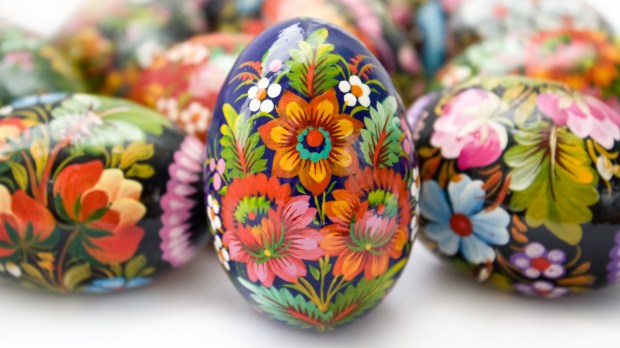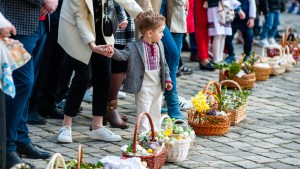An ancient custom from Ukraine feels especially meaningful this Easter, as it’s become a symbol of hope in dark times. The gorgeous pysanky eggs are a long-standing Easter tradition, and have become a way to show support for Ukrainians at this crucial moment in their history.
Pysanky eggs are nothing like the simple vinegar-dyed eggs you might have made as a kid. These eggs are decorated with a hot wax and indelible dye technique that is tricky and time-consuming but incredibly beautiful and elaborate.
You can see how to make them here:
An ancient and powerful custom
For Ukrainians, pysanky eggs are an essential part of the Easter celebrations. They’ve been a part of Ukrainian spring festivals since long before the time of Christ: Pysanky “dates back to the pre-Christian era.”
Back then, “the eggs were believed to contain great powers,” according to the pysanky artists who wrote Eggs Beautiful: How to make Ukrainian Easter Eggs. Pre-Christian Ukrainians believed that the eggs could cure infertility, protect homes from fire, control weather, prevent famine, and ensure good health.
So when Christianity reached Europe, the Ukrainians didn’t stop making their beloved eggs. Instead, the pysanky tradition converted right alongside them:
With the introduction of Christianity to Ukraine in 988 A.D., the “sun” became the “Son” and the ancient customs were absorbed into the Christian celebration of Christ’s resurrection. On Easter the triangle designs on the eggs which had represented air, fire, and water now became the symbols for the Father, Son, and Holy Spirit. The old supernatural powers in the decorated eggs were gradually attributed to almighty God. The new meanings blended so harmoniously with the old that even today the mixture of pagan and Christian symbolism can be seen in the designs. (Eggs Beautiful, 17)
The colored Easter eggs were still perceived to have supernatural powers after their Christianization. One tradition held that colored egg shells could reach the land of the Blazhenni, “the souls of children who died before their baptism”:
“At Easter time the women, who celebrate their festival, threw red krashanky egg shells into the streams. The flowing water carried the tokens away to that distant land, bringing back the message that Easter had been celebrated, so that the Blazhenni could observe the festival themselves… Behind the beliefs in this mysterious cult lies the deep grief of bereaved mothers. In a time of high infant mortality, mothers somehow felt relieved that the souls of their children were dwelling in a safe loving place.” (Eggs Beautiful, 18)
Another legend concerning death directed a grieving family to place a colored egg in the loose soil over a loved one’s grave.
If the family returned and found the eggs unblemished and intact, they knew the soul had been accepted and was safe in heaven. If there were marks on the egg, or if an animal had taken it during the night, then certainly the departed one needed assistance from his family, including many prayers. (Eggs Beautiful, 19)
Another legend supposed that the eggs actually prevented death:
In serious illness, an egg, blessed on Easter eve, was hung around the neck on a string and the disease was passed into it. (Eggs Beautiful, 20)
Pysanky eggs bring goodness to the world
These legends about the magical powers of Easter eggs may have faded away, but the tradition of making pysanky eggs is alive and well.
Perhaps the most interesting legend is the reason pysanky eggs feel especially significant this year.
Another Hutzul tale has the answer to the problems of the world! According to this tale it is believed that the fate of the world depends upon the pysanka; that as long as the pysanka tradition remains, and eggs continue to be decorated, the world will exist. Should the custom cease, evil will encompass and destroy the world, because an ancient, vicious creature lies heavily chained against a huge cliff and each year advocates of the creature encircle the earth to keep a record of the number of pysanky decorated. When there are few decorated eggs the creatures chains loosen and evil begins to flow throughout the world. However, should these advocates find the custom of decorating eggs practiced extensively, the chains of the monster tighten, allowing love to conquer evil. (Eggs Beautiful, 20)
The idea that pysanky eggs bring goodness and love into the world and conquer evil has inspired a renewed sharing of pysanky eggs and art, both in solidarity with Ukraine and also to benefit Ukraine.
The Washington Post shared the story of a Ukrainian-American woman who held a workshop to teach the art of pysanky, donating the proceeds to Ukrainian relief efforts. She said,
“We need to make as many as we can because so many people are displaced and cannot make any this year. If this legend holds true, then it is our job to make as many as we can to keep evil at bay… Each time has felt very important, but this year felt very urgent to me. I wanted to do something to help, and that was the only way I knew how to help.”
Another pysanky workshop teacher shares the same legend and “tells participants they are ‘saving the world, one egg at a time.’”
This year, as you’re dying Easter eggs, hiding them, or eating them, you might think of the ancient legends behind these loveliest of all colored eggs, and feel inspired to offer a heartfelt prayer for Ukraine.



